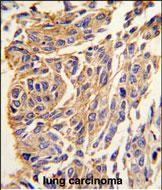PPT1 Antibody (C-term)
Purified Rabbit Polyclonal Antibody (Pab)
- 产品详情
- 实验流程
- 背景知识
Application
| WB, IHC-P, E |
|---|---|
| Primary Accession | P50897 |
| Other Accession | Q8HXW6 |
| Reactivity | Human |
| Predicted | Monkey |
| Host | Rabbit |
| Clonality | Polyclonal |
| Isotype | Rabbit IgG |
| Calculated MW | 34193 Da |
| Antigen Region | 269-300 aa |
| Gene ID | 5538 |
|---|---|
| Other Names | Palmitoyl-protein thioesterase 1, PPT-1, Palmitoyl-protein hydrolase 1, PPT1, PPT |
| Target/Specificity | This PPT1 antibody is generated from rabbits immunized with a KLH conjugated synthetic peptide between 269-300 amino acids from the C-terminal region of human PPT1. |
| Dilution | WB~~1:1000 IHC-P~~1:100~500 E~~Use at an assay dependent concentration. |
| Format | Purified polyclonal antibody supplied in PBS with 0.09% (W/V) sodium azide. This antibody is prepared by Saturated Ammonium Sulfate (SAS) precipitation followed by dialysis against PBS. |
| Storage | Maintain refrigerated at 2-8°C for up to 2 weeks. For long term storage store at -20°C in small aliquots to prevent freeze-thaw cycles. |
| Precautions | PPT1 Antibody (C-term) is for research use only and not for use in diagnostic or therapeutic procedures. |
| Name | PPT1 |
|---|---|
| Synonyms | CLN1 {ECO:0000303|PubMed:19941651}, PPT |
| Function | Has thioesterase activity against fatty acid thioesters with 14 -18 carbons, including palmitoyl-CoA, S-palmitoyl-N- acetylcysteamine, and palmitoylated proteins (PubMed:12855696, PubMed:26731412, PubMed:8816748). In contrast to PPT2, PPT1 can hydrolyze palmitoylated proteins and palmitoylcysteine (PubMed:12855696). |
| Cellular Location | Lysosome. Secreted Golgi apparatus. Endoplasmic reticulum |
For Research Use Only. Not For Use In Diagnostic Procedures.
Provided below are standard protocols that you may find useful for product applications.
BACKGROUND
Palmitoyl-protein thioesterase-1 (PPT1) is a lysosomal hydrolase that removes long-chain fatty acyl groups from modified cysteine residues in proteins. Mutations in PPT1 have been found to cause the infantile form of neuronal ceroid lipofuscinosis (INCL), and an animal model has been developed.1 The deduced PPT2 protein contains 302 amino acids, including a 27-amino acid leader peptide, a sequence motif characteristic of many thioesterases and lipases, and 5 potential N-linked glycosylation sites.2 PPT2 shares 18% amino acid identity with PPT1. Northern blot analysis detected a predominant 2.0-kb PPT2 transcript in the human tissues examined, with the highest expression in skeletal muscle; variable amounts of 2.8- and 7.0-kb transcripts were also observed. Recombinant PPT2, like PPT1, possesses thioesterase activity and localizes to the lysosome. Since PPT2 could not substitute for PPT1 in correcting the metabolic defect in INCL cells and was unable to remove palmitate groups from palmitoylated proteins that are routinely used as substrates for PPT1it has been postulated that PPT2 possesses a different substrate specificity than PPT1.
REFERENCES
Calero, G., et al., J. Biol. Chem. 278(39):37957-37964 (2003).
Hofmann, S.L., et al., Curr. Mol. Med. 2(5):423-437 (2002).
Weimer, J.M., et al., Neuromolecular Med. 1(2):111-124 (2002).
Lu, J.Y., et al., Proc. Natl. Acad. Sci. U.S.A. 93(19):10046-10050 (1996).
Crews, C.M., et al., Proc. Natl. Acad. Sci. U.S.A. 93(9):4316-4319 (1996).
终于等到您。ABCEPTA(百远生物)抗体产品。
点击下方“我要评价 ”按钮提交您的反馈信息,您的反馈和评价是我们最宝贵的财富之一,
我们将在1-3个工作日内处理您的反馈信息。
如有疑问,联系:0512-88856768 tech-china@abcepta.com.























 癌症的基本特征包括细胞增殖、血管生成、迁移、凋亡逃避机制和细胞永生等。找到癌症发生过程中这些通路的关键标记物和对应的抗体用于检测至关重要。
癌症的基本特征包括细胞增殖、血管生成、迁移、凋亡逃避机制和细胞永生等。找到癌症发生过程中这些通路的关键标记物和对应的抗体用于检测至关重要。 为您推荐一个泛素化位点预测神器——泛素化分析工具,可以为您的蛋白的泛素化位点作出预测和评分。
为您推荐一个泛素化位点预测神器——泛素化分析工具,可以为您的蛋白的泛素化位点作出预测和评分。 细胞自噬受体图形绘图工具为你的蛋白的细胞受体结合位点作出预测和评分,识别结合到自噬通路中的蛋白是非常重要的,便于让我们理解自噬在正常生理、病理过程中的作用,如发育、细胞分化、神经退化性疾病、压力条件下、感染和癌症。
细胞自噬受体图形绘图工具为你的蛋白的细胞受体结合位点作出预测和评分,识别结合到自噬通路中的蛋白是非常重要的,便于让我们理解自噬在正常生理、病理过程中的作用,如发育、细胞分化、神经退化性疾病、压力条件下、感染和癌症。








